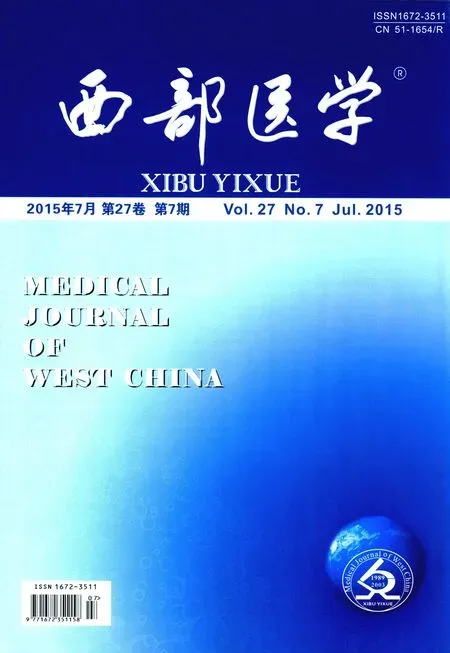常规与具有保护盘的负压吸引在腹创伤修复中肠壁微血管流速变化的实验研究*
2015-06-15潘勇王凯杨春
潘勇 王凯 杨春
(1. 四川省人民医院胃肠外科, 四川 成都 610072; 2. 四川省人民医院城东病区创伤研究所, 四川 成都 610072)
常规与具有保护盘的负压吸引在腹创伤修复中肠壁微血管流速变化的实验研究*
潘勇1王凯2杨春1
(1. 四川省人民医院胃肠外科, 四川 成都 610072; 2. 四川省人民医院城东病区创伤研究所, 四川 成都 610072)
目的 使用常规负压伤口治疗技术(negative pressure wound therapy NPWT) 和具有保护盘的NPWT测量微血管内血液流速在肠壁和大网膜之间的变化。方法 将12头实验用猪行正中切口开腹并应用负压伤口治疗技术,随机分为常规NPWT组6头(传统组)和在小肠和负压源之间放置有保护盘NPWT组6头(保护盘组) 。使用激光多普勒测速仪测量两组分别使用负压值为 -50、-70、-100、-120、-150和-170 mmHg的负压伤口治疗装置下的相关肠襻和大网膜微血管内血液流速。结果 传统组动物血管壁的微血管血流速度显著低于保护盘组(P<0.01)。在负压值为-50mmHg的负压伤口治疗中,保护盘组血流灌注大于传统组(2.5±0.1)PU VS(2.0±0.2)PU(P<0.05);在负压值为-170mmHg的负压伤口治疗中,保护盘组的血流灌注大于传统组(3.4±0.3)PU VS (1.5±0.2)PU(P<0.01)。结论 传统NPWT中微血管血流量比具有保护盘的NPWT 显著降低,且血流量随着负压值的增加而减少。负压伤口治疗术在开放性腹部伤口治疗中是一种非常有效的治疗方法。保护盘具有保护小肠,维持微血管血流量的作用。
负压伤口治疗; 开放性腹部; 微血管内血液流速; 小肠壁
在过去的20年里,针对如腹腔间隔室综合征、伤口裂开、腹内脓毒症[1~5]等疾病开展的剖腹探查手术,已成为一个拯救生命干预措施的紧急外科手术。伤口管理的主要目标包括避免机械污染腹腔脏器,有效去除分泌物,第三间隙液体损失的估计,感染控制及预防肠瘘[6]。传统(常规)负压伤口治疗(NPWT)是通过吸引管治疗,适用的原则是局部负压(TNP)和闭塞辅料抽吸腹膜腔中的废液,其主要缺点是易形成腹疝,需要后期处理。使用密闭性辅料及真空治疗技术来处理开放性腹部,提高了护理和增加了关闭腹腔的可能性。但是,这种方法偶尔会伴有肠瘘的发生[7,8]。NPWT可能会导致肠管的局部缺血,这反过来又可以促进瘘的发展。本文采用光纤激光多普勒探头测量微血管内血流流速,研究常规 NPWT 及具有保护盘(外购设备)的 NPWT 在肠壁局部负压在-50和-170mmHg之间变化过程中,对血流量变化的影响。
1 实验与方法
1.1 研究对象 选择12条不同性别的实验用健康猪,平均体重60公斤左右。实验前动物禁食过夜,但可自由饮水。
1.2 实验方法 实验动物术前肌注胺碘酮(30 mg/Kg),泮库溴胺(0.5 mg/Kg),然后用7.5 mm的气管进行插管,呼吸机用于机械通气。整个实验所用的呼吸参数设置为:每分钟通气量=100 ml/Kg,FiO2=0.5,呼吸频率为16次/分,呼吸末压力为0.5 cm水柱,麻醉和肌肉麻痹,保持异丙酚8~10 mg/Kg·h(得普利麻,瑞典 阿斯利康公司)、芬太尼0.15 mg/Kg·h和泮库溴胺0.6mg/Kg·h连续滴注。
1.2.1 实验用猪腹部作一条30cm长的正中切口,使用V.A.C.麻粒泡沫腹部敷料系统(KIC.美国)。内脏的保护层被裁减成合适的大小,两侧延伸到结肠旁沟(约30cm宽和35cm长)。在内脏保护层顶部与伤口边缘之间放置一层聚氨酯泡沫(V.A.C.造粒泡沫)伤口覆盖带自粘性的吸盘,通过吸盘与连续的负压源相连接。整个实验记录心率与呼吸机参数。微血管内血液流速测量由LDV使用一种技术,量化红细胞在一个特定的体积里运动的总和。冲击下运动细胞光波长会有变化,而静态物体会保持不变。幅度和频率分布的变化有直接关系的是红细胞的数量和速度。该信息被回来的纤维收集,转换成电子信号并分析[14]。激光多普勒探针插入到网膜和回肠回路的肠壁内被缝合到内脏的保护层的内表面中心,见图1。

图1 该图显示负压治疗系统在腹部安装和激光多普勒探针的位置
Figure 1 The picture shows NPWT installed in the abdomen and the location of the laser Doppler probe
1.2.2 实验设计 微血管内血液流速被激光多普勒长丝探头连续测量。设置完毕后,允许有30分钟的恢复时间,再此期间内负压装置中无负压。在常规 NPWT 和实验中具有保护盘的 NPWT 负压值均为-50、-70、-100、-120、-150和、170mmHg时做记录。基线在各个压力设置间恢复。采用随机顺序的压力,防范系统性影响。实验设计,见图2。

图2 实验设置示意图
Figure 2 Schematic diagram of experiment
注:a.激光多普勒的灯丝探针用于测量血流量的小肠壁的照片;b.激光多普勒机
1.3 统计学分析 组间比较采用卡方检验,P<0.05为差异有统计学意义。
2 结果
2.1 两组实验用猪小肠壁微血管血流分析 测量缝合在敷料上腹部小肠襻的微血管内血液流速,结果显示,保护盘组血流速度明显高于传统组(P<0.05),见图3。
2.2 保护盘组和传统组分别在-50、-70、-100、-120、-150、-170时的血流测速值及比较有明显差异(P<0.05),见表1。
表1 保护盘组和传统组负压模式血流测速值的比较。
Table 1 Blood flow velocity of protective plate and t traditional model of negative pressure

负压值(mmHg)血流测速值( x±s)保护盘组传统组P-502.5±0.12.0±0.1<0.05-703.6±0.12.5±0.1<0.05-1003.8±0.12.7±0.1<0.01-1203.7±0.12.3±0.1<0.01-1503.4±0.11.9±0.1<0.01-1703.2±0.11.5±0.1<0.01
3 讨论
管理开放的腹部严重受伤或严重的腹腔感染的病人对医生来说是一个重大的挑战,并可能造成腹腔间隔室综合征,影响呼吸,心血管,肾功能,甚至急诊开腹手术治疗。对严重的腹部损伤的患者进行维持生命的紧急手术,往往伴有内脏水肿,腹腔积液或腹膜后血肿。被迫封闭腹壁的压力或腹腔感染,可能会导致腹部筋膜的缺血和坏死。后者可能导致腹部破裂腹壁疝的后续发展[1~3,5,9,15,16]。随着损伤控制技术和腹腔室隔综合征的认识的发展,开放的腹部变得更加普遍。如果术后早期没有关闭腹部,粘连与筋膜回缩会经常使主要筋膜不能关闭,往往在腹部形成腹疝。NPWT 采用吸入应用到下一个大型聚氨酯海绵包扎伤口,允许恒定内侧牵引腹部筋膜。该技术还允许腹壁向中线自由移动而不干扰肠与腹壁之间的粘连。NPWT具有排水效果,促进减少腹腔渗液及细菌。虽然报道称NPWT比其他技术有更高的治愈率[4,5,9,10,16]。但是,这种技术偶尔被报道与瘘的发展增加有关[5,13,17]. NPWT的机械效应可能会导致缺血,这反过来又可以促进瘘的发展。

图3 激光多普勒测速仪测量两组实验猪小肠壁的微血管血流量
Figure 1 Using laser doppler velocimeter to measure small intestinal wall of microvascular blood flow,White column charts is a protective plate of NPWT, gray bar chart is a traditional NPWT
注:白色柱形图为保护盘组,灰色柱形图为传统组。NPWT的负压分别是A.-50mmHg,B.-70mmHg,C.-100mmHg,D.-120mmHg,E.-150mmHg, F.-170mmHg。在与VAC吸盘中心相连的小肠襻测量数据
在本研究中,我们展示了小肠壁的血流在传统NPWT较具有保护盘的 NPWT 在负压值在-50 至-170 mmHg之间有明显的降低。结果还表明,血流量的减少与所用的负压值增加而增加。例如,负压值为-170mmHg时肠壁血流量的减少大于使用负压值为-150mmHg时减少的量,且负压值为-150mmHg时肠壁血流量的减少大于使用负压值为-120mmHg时减少的量。在应用NPWT 敷料后,将动物无压力保持不变30分钟(0 mmHg),连续测量小肠壁的微血管内血液流速。在之后30至60秒内稳态建立。瞬间施加负压后,可以目睹血流量的减少,30~60秒后稳态建立,记录在建立后大约15分钟后开始。
在稳定状态成立后这段时间内没有发现肠壁和内微血管血液流速的变化。已有的资料表明,压力在松软和致密组织中转换是不一样,密度较小的组织在压力影响下更容易崩溃[18]。观察到伤口边缘区域的相对低灌注。低灌注区域的大小依赖于所施加的负压和负压增加的扩大。总之,伤口局部血流量的变化是由到伤口边缘距离的局部压力引起的。伤口边缘几厘米远的组织在负压施加时血流量增加。 相反,在紧邻伤口的组织,负压诱导相对低灌注[18]。从理论上说,这些生理效应也可能出现在施加有局部负压的肠壁和大网膜。负压值大的 NPWT 理论上可以在 VAC 装置封闭的肠壁和网膜上产生很大的缺血区,并有可能导致肠瘘的发展。本研究结果的另一种解释可能是,开放性的腹部应用 NPWT ,创建了一个伤口边缘之间的疝,且疝随着NPWT应用的量的增加而增加。当开放性腹部伤口使用负压创伤治疗时,可以发生类似的机制,即,鼓胀的小肠挤进伤口边缘之间的空间内,这可以部分解释开放性腹部伤口负压伤口治疗时小肠壁的缺血。
4 结论
本实验表明,开放性腹部伤口应用负压伤口治疗,会诱导小肠和大网膜缺血。传统NPWT中微血管血流量比具有保护盘的NPWT 显著降低。实验还表明,血流量减少与负压增加呈负相关。肠壁血流量持续减少,会导致肠壁缺血和继发性坏死,这可能会诱发肠瘘的发展。但这些研究结果在临床上可能有不确定因素。开放性腹部伤口应用 NPWT 是一种非常有效的治疗,主要是由于他的排水效果,但有保护盘的NPWT既可以保护局部缺血,又可提供有效的排水,对临床进一步实验研究具有重要的帮助。
[1]Schecter WP, Ivatury RR, Rotondo MF,etal. Open abdomen after trauma and abdominal sepsis: a strategy for management[J].JAm Coll Surg, 2006, 203(3):390-396.
[2]Swan MC, Banwell PE. The open abdomen: aetiology, classification and current management strategies[J]. Wound Care, 2005, 14(1):7-11.
[3]Deenichin GP.Abdominal compartment syndrome[J]. Surg Today, 2008,38(1):5-19.
[4]Acosta S, Bjarnason T, Petersson U,etal.Multicentre prospective study of fascial closure rate after open abdomenwith vacuum and mesh-mediated fascial traction [J]. Br Surg, 2011,98(3):735-743.
[5]Cheatham ML, Safcsak K.Is the evolving management of intra-abdominal hypertension and abdominal compartment syndrome improving survival[J]. Crit Care Med, 2010, 38(4):402-407.
[6]Stevens P.Vacuum-assisted closure of laparostomy wounds: a critical review of the literature[J]. Int Wound, 2009, 6(4):259-266.
[7]Amin AI, Shaikh IA. Topical negative pressure in managing severe peritonitis: a positive contribution [J]. World J Gastroenterol, 2009, 15(4):3394-3397.
[8]DeFranzo AJ, Argenta L. Vacuum-assisted closure for the treatment of abdominal wounds [J]. Clin Plast Surg, 2006,33(1):213-224.
[9]Cheatham ML, Malbrain ML, Kirkpatrick A,etal. Results from the International Conference of Experts on Intra-abdominal Hypertension and Abdominal Compartment Syndrome II [J]. Intensive Care Med, 2007, 33(3):951-962.
[10] Perez D, Wildi S, Demartines N,etal. Prospective evaluation of vacuum-assisted closure in abdominal compartment syndrome and severe abdominal sepsis [J]. Am Coll Surg, 2007, 205(1):586-592.
[11] Petersson U, Acosta S, Bjorck M. Vacuum-assisted wound closure and mesh-mediated fascial traction-a novel technique for late closure of the open abdomen [J]. World J Surg, 2007, 31(4):2133-2137.
[12] Shaikh IA, Ballard-Wilson A, Yalamarthi S,etal. Use of topical negative pressure 'TNP' in assisted abdominal closure does not lead to high incidence of enteric fistulae [J]. Colorectal Dis, 2009, 12(3):931-934.
[13] Ubbink DT, Westerbos SJ, Nelson EA,etal. A systematic review of topical negative pressure therapy for acute and chronic wounds [J]. Br J Surg, 2008, 95(2):685-692.
[14] Zografos GC, Martis K, Morris DL. Laser Doppler flowmetry in evaluation of cutaneous wound blood flow using various suturing techniques [J]. Ann Surg,1992,215(1):266-268.
[15] Bee TK, Croce MA, Magnotti LJ,etal. Temporary abdominal closure techniques: a prospective randomized trial comparing polyglactin 910 mesh and vacuum-assisted closure [J].J Trauma ,2008,65(1):337-342.
[16] Malbrain ML, De laet I, Cheatham M. Consensus conference definitions and recommendations on intra-abdominal hypertension (IAH) and the abdominal compartment syndrome (ACS)-the long road to the final publications, how did we get there [J]. Acta Clin Belg Suppl,2007,45 (1):44-59.
[17] Evenson RA, Fischer JE. Treatment of enteric fistula in open abdomen [J]. Chirurg ,2006,77(2):594-601.
[18] Wackenfors A, Gustafsson R, Sjogren J,etal. Blood flow responses in the peristernal thoracic wall during vacuum-assisted closure therapy [J]. Ann Thorac Surg,2005, 79(3):1724-1730.
Microvascular blood flow response in the intestinal wall during negative pressure wound therapy of the open abdomen using conventional negative pressure wound therapy and NPWT with a protective disc over the intestines
PAN Yong1,WANG Kai2,YANG Chun1
(1.DepartmentofGastrointestinalSurgery,SichuanProvincialPeople'sHospital,Chengdu610072,China; 2.SichuanProvincialPeople'sHospital,Chengdu610072,China)
Objective The present study measured microvascular blood flow in the intestinal wall using conventional NPWT and NPWT with a protective disc between the intestines and the vacuum source. Methods 12 pigs underwent midline incision and application of NPWT to the open abdomen. The microvascular blood flow in the underlying intestinal loop wall was recorded with conventional NPWT and NPWT with a protective disc between the intestines and the vacuum source of -50,-70,-100,-120,-150, and -170mmHg respectively, using laser Doppler velocimetry.Results A significant decrease in microvascular blood flow was seen in the intestinal wall during application of all negative pressures levels. The flow was 2.5(±0.1) Perfusion Units (PU) with NPWT with a protective disc and 2.0(±0.2) PU(P<0.05) with conventional NPWT of -50 mmHg,and 3.4(±0.6)PU with NPWT with a protective disc and 1.5 (±0.2) PU (P<0.01) with conventional NPWT of -170 mmHg. Conclusion In the present study, the microvascular blood flow in the intestinal wall were significantly smaller following conventional NPWT, than using NPWT with a protective disc between the intestines and the vacuum source.The decrease in blood flow inceased with the amount of negative pressure applied. We believe that NPWT of the open abdomen is a very effective treatment but could probaly be improved.
Negative pressure wound therapy; Open abdomen; Microvascular blood flow; Intestinal wall
四川省科技厅科研项目(30504010107;30305030273)
R 656
A
10.3969/j.issn.1672-3511.2015.07.004
2014-08-01; 编辑: 陈舟贵)
